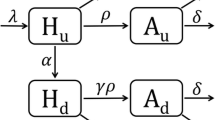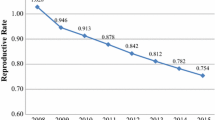Abstract
Three key policy questions are explored here: Is it still epidemiologically feasible to attain the incidence and transmission rate reduction goals of the U.S. National HIV/AIDS Strategy (NHAS) by 2015? If so, what costs will be incurred in necessary program expansion, and will the investment be cost-effective? Would substantial expansion of prevention services for persons living with HIV (PLWH) augment the other strategies outlined in the NHAS in terms of effectiveness and cost-effectiveness? Eight policy scenarios were constructed based on three factors (two levels each): expansion (or not) of HIV diagnostic services; assumptions regarding levels of effectiveness of HIV treatment in achieving suppressed viral load; and possible levels of expansion of prevention services for PLWH. All scenarios assumed that the NHAS goal of 85 % linkage to HIV care would be fully achieved by 2015. Standard methods of economic evaluation and epidemiologic modeling were employed. Each of the eight policy scenarios was compared to a flat transmission rate comparison condition; then, key policy dyads were compared pairwise. Without expansion of diagnostic services and of prevention services for PLWH, scaling up coverage of HIV care and treatment alone in the U.S. will not achieve the incidence and transmission rate reduction goals of the NHAS. However, timely expansion of testing and prevention services for PLWH does allow for the goals to still be achieved by 2015, and does so in a highly cost-effective manner.

Similar content being viewed by others
References
The White House Office of National AIDS Policy. National HIV/AIDS strategy for the United States. Washington D.C.: White House; 2010.
Holtgrave DR. On the epidemiologic and economic importance of the National AIDS Strategy for the United States. J Acquir Immune Defic Syndr. 2010;55(2):139–42.
Hall HI, Green TA, Wolitski RJ, et al. Estimated future HIV prevalence, incidence, and potential infections averted in the United States: a multiple scenario analysis. J Acquir Immune Defic Syndr. 2010;55(2):271–6.
Cohen MS, Chen YQ, McCauley M, et al. Prevention of HIV-1 infection with early antiretroviral therapy. N Engl J Med. 2011;365(6):493–505.
Prejean J, Song R, Hernandez A, et al. Estimated HIV Incidence in the United States, 2006–2009. PLoS ONE. 2011;6(8):e17502.
CDC. HIV surveillance—United States, 1981–2008. MMWR. 2011;60:689–93.
Holtgrave DR, Hall HI, Prejean J. HIV transmission rates in the United States, 2006–2008. The Open AIDS J. 2012;6:26–8.
Hall HI, Holtgrave DR, Maulsby C. HIV transmission rates from persons living with HIV who are aware and unaware of their infection, United States. AIDS. 2012;26(7):893–6.
Holtgrave DR, Maulsby C, Wehrmeyer L, Hall HI. Behavioral factors in assessing impact of HIV treatment as prevention. AIDS Behav (Epub ahead of print).
Kaiser Family Foundation. U.S. Federal Funding for HIV/AIDS: the President’s FY 2013 budget request. Online factsheet available at http://www.kff.org/hivaids/upload/7029-08.pdf. Accessed 08 Apr 2012.
Gardner EM, McLees MP, Steiner JF, Del Rio C, Burman WJ. The spectrum of engagement in HIV care and its relevance to test-and-treat strategies for prevention of HIV infection. Clin Infect Dis. 2011;52(6):793–800.
CDC. Vital signs: HIV prevention through care and treatment—United States. MMWR. 2011;60:1618–23.
National Alliance of State & Territorial AIDS Directors (NASTAD). ADAP Watch. Feb 24, 2012. Available at http://www.nastad.org/Docs/012236_ADAP%20Watch%20update%20-%202.24.12.pdf. Accessed 2 and 5 Mar 2012.
Gold M. Panel on cost-effectiveness in health and medicine. Med Care. 1996;34(12 Suppl):DS197–9.
Pinkerton SD, Holtgrave DR. Assessing the cost-effectiveness of HIV prevention interventions: a primer. In: Holtgrave DR, editor. Handbook of economic evaluation of HIV prevention programs. New York: Plenum Press; 1998. p. 34–41.
Mahle Gray K, Tang T, Shouse L, Li Jianmin, Mermin J, Hall HI. Using the HIV surveillance system to monitor the national HIV/AIDS strategy. Am J Public Health. (in press).
Skarbinski J, Johnson C, Frazier E, Beer L, Valverde E, Heffelfinger J. Nationally representative estimates of the number of HIV+ adults who received care, were prescribed ART, and achieved viral suppression—Medical Monitoring Project, 2009 to 2010—US. Presented at the 19th conference on Retroviruses and Opportunistic Infections (CROI). Seattle, March 5–8, 2012.
Kalichman SC, Cherry C, Kalichman MO, et al. Integrated behavioral intervention to improve HIV/AIDS treatment adherence and reduce HIV transmission. Am J Public Health. 2011;101(3):531–8.
Wingood GM, DiClemente RJ, Mikhail I, et al. A randomized controlled trial to reduce HIV transmission risk behaviors and sexually transmitted diseases among women living with HIV. The WiLLOW program. J Acquir Immune Defic Syndr. 2004;37:S58–67.
Rotheram-Borus M, Swendeman D, Comulada S, Weiss RE, Lee M, Lightfoot M. Prevention for substance-using HIV positive young people: telephone and in-person delivery. J Acquir Immune Defic Syndr. 2004;37(2):S68–77.
Healthy Living Project Team. Effects of a behavioral intervention to reduce risk of transmission among people living with HIV: the Healthy Living Project randomized controlled study. J Acquir Immune Defic Syndr. 2007;44:213–21.
Freedman M, Mattson C, Johnson C, et al. Medical monitoring project, 2009 to 2010. National representative estimates of sexual risk behaviors among HIV+ adults receiving medical care: U.S. 19th conference on retroviruses and opportunistic infections, Seattle, 2012 (abstract #1090).
CDC. HIV Cost-effectiveness. Web-based resource available at http://www.cdc.gov/hiv/topics/preventionprograms/ce/index.htm. Accessed 09 Apr 2012.
Hutchinson AB, Farnham PG, Duffy N, et al. Return on public health investment: CDC’s expanded HIV testing initiative. J Acquir Immune Defic Syndr. 2012;59(3):281–6.
Lasry A, Sansom SL, Hicks KA, Uzunangelov V. A model for allocating CDC’s HIV prevention resources in the United States. Health Care Manag Sci. 2011;14(1):115–24.
Cassidy-Stewart H, Holtgrave DR. Mathematical modeling and economic analysis to improve local HIV prevention and care planning: Baltimore/Towson. Presented at the national HIV prevention conference, Atlanta. Aug 14–17, 2011 (abstract no. 1823).
Chen RY, Accortt NA, Westfall AO, et al. Distribution of health care expenditures for HIV-infected patients. Clin Infect Dis. 2006;42(7):1003–10.
Holtgrave DR. Costs and consequences of the US Centers for Disease Control and Prevention’s recommendations for opt-out HIV testing. PLoS Med. 2007;4(6):e194.
Holtgrave DR, Briddell K, Little E, et al. Cost and threshold analysis of housing as an HIV prevention intervention. AIDS Behav. 2007;11(6 Suppl):162–6.
Farnham PG, Sansom SL, Hutchinson AB. How much should we pay for a new HIV diagnosis? A mathematical model of HIV screening in US clinical settings. Med Decis Making. 2012. (Epub ahead of print).
Institute of Medicine of the National Academies. Public financing and delivery of HIV/AIDS care: securing the legacy of Ryan White. Washington: The National Academies Press; 2004.
Holtgrave DR, Maulsby C, Kharfen M, et al. Cost-utility analysis of a female condom promotion program in Washington, DC. AIDS Behav. 2012. (Epub ahead of print).
Holtgrave DR, Wolitski RJ, Pals SL, et al. Cost-utility analysis of the housing and health intervention for homeless and unstably housed persons living with HIV. AIDS Behav. (in press).
Nakagawa F, Lodwick RK, Smith CJ, et al. Projected life expectancy of people with HIV according to timing of diagnosis. AIDS. 2012;26(3):335–43.
Burgoyne RW, Rourke SB, Behrens DM, Salit IE. Long-term quality-of-life outcomes among adults living with HIV in the HAART era: the interplay of changes in clinical factors and symptom profile. AIDS Behav. 2014;8(2):151–63.
Burgoyne RW, Tan DHS. Prolongation and quality of life for HIV-infected adults treated with highly active antiretroviral therapy (HAART): a balancing act. J Antimicrob Chemother. 2008;61:469–73.
Airoldi M, Zaccarelli M, Bisi L, et al. One-pill once-a-day HAART: a simplification strategy that improves adherence and quality of life of HIV-infected subjects. Patient Prefer Adherence. 2010;4:115–25.
Wolitski RJ, Kidder DP, Pals SL, et al. Randomized trial of the effects of housing assistance on the health and risk behaviors of homeless and unstably housed people living with HIV. AIDS Behav. 2010;14(3):493–503.
Marks G, Crepaz N, Janssen RS. Estimating sexual transmission of HIV from persons aware and unaware that they are infected with the virus in the USA. AIDS. 2006;20(10):1447–50.
Conflict of Interest
This manuscript was prepared as part of Government work (HIH) and there are no other funding sources to declare (DRH, CM, LW). No conflicts of interest to declare.
Author information
Authors and Affiliations
Corresponding author
Rights and permissions
About this article
Cite this article
Holtgrave, D.R., Hall, H.I., Wehrmeyer, L. et al. Costs, Consequences and Feasibility of Strategies for Achieving the Goals of the National HIV/AIDS Strategy in the United States: A Closing Window for Success?. AIDS Behav 16, 1365–1372 (2012). https://doi.org/10.1007/s10461-012-0207-0
Published:
Issue Date:
DOI: https://doi.org/10.1007/s10461-012-0207-0




